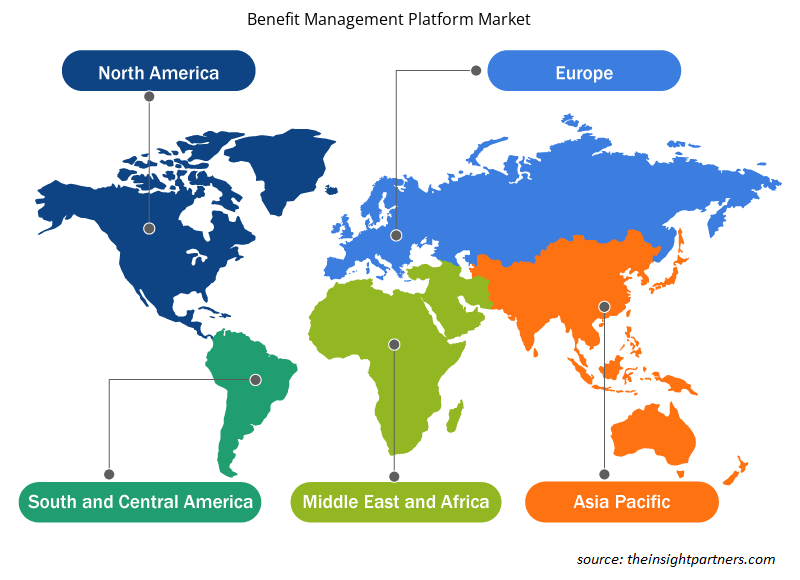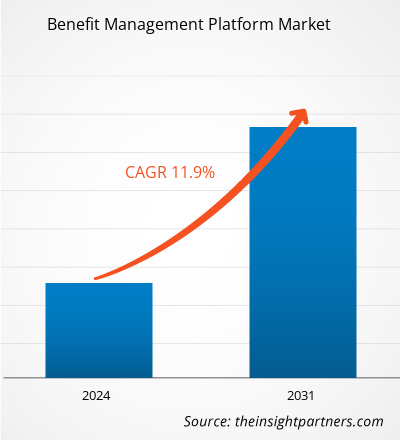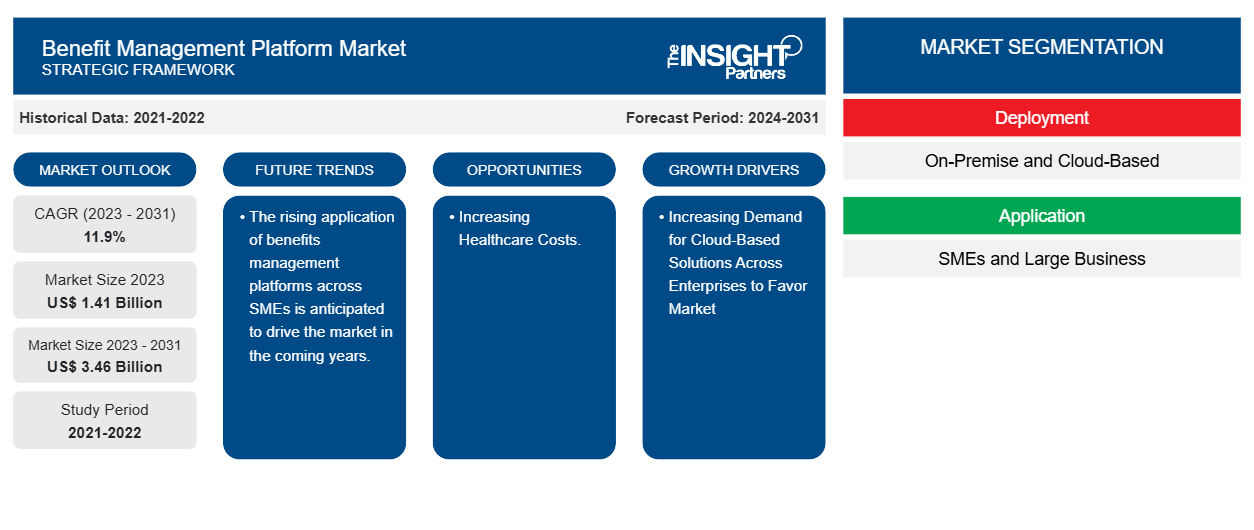Se prevé que el tamaño del mercado de plataformas de gestión de beneficios alcance los 3.460 millones de dólares estadounidenses en 2031, frente a los 1.410 millones de dólares estadounidenses en 2023. Se espera que el mercado registre una CAGR del 11,9 % durante el período 2023-2031. Es probable que el crecimiento creciente de las soluciones basadas en la nube en diversas empresas y los mayores costos de la atención médica sigan siendo tendencias e impulsores clave en el mercado.
Análisis del mercado de plataformas de gestión de beneficios
Se prevé que la demanda del mercado de plataformas de gestión de beneficios aumentará con el crecimiento creciente de las soluciones basadas en la nube en las empresas y la mayor demanda de conveniencia respaldada por las tecnologías; los mayores costos de la atención médica están impulsando el crecimiento del mercado. Además, se prevé que varias iniciativas gubernamentales y el aumento de las aplicaciones en las pymes impulsarán el crecimiento del mercado en el período de pronóstico.
Descripción general del mercado de plataformas de gestión de beneficios
Las plataformas de gestión de beneficios están diseñadas para reconocer el comportamiento de un empleado y ayudar al empleador a ofrecer diversos beneficios para que las operaciones comerciales sean eficientes. Estas soluciones son útiles para mejorar la moral del personal y recompensar su empleo en la organización. Estas plataformas se utilizan con frecuencia en empresas de prácticamente todos los tamaños debido a sus innovaciones tecnológicas.
Personalice este informe según sus necesidades
Obtendrá personalización en cualquier informe, sin cargo, incluidas partes de este informe o análisis a nivel de país, paquete de datos de Excel, así como también grandes ofertas y descuentos para empresas emergentes y universidades.
-
Obtenga las principales tendencias clave del mercado de este informe.Esta muestra GRATUITA incluirá análisis de datos, desde tendencias del mercado hasta estimaciones y pronósticos.
Impulsores y oportunidades del mercado de plataformas de gestión de beneficios
La creciente demanda de soluciones basadas en la nube en las empresas favorece el mercado
La creciente demanda de soluciones basadas en la nube en las empresas está impulsando el crecimiento del mercado de plataformas de gestión de beneficios. Las soluciones basadas en la nube pueden escalar fácilmente para adaptarse al crecimiento de las empresas, ya sea que estén agregando nuevos empleados o expandiéndose globalmente. Las plataformas de gestión de beneficios también pueden reducir el costo de los modelos de suscripción de TI. Además, mejora el acceso remoto a actualizaciones en tiempo real. Además, existen varias plataformas de gestión de beneficios en el mercado. Por ejemplo, Zenefits es una plataforma de RR.HH. basada en la nube que ofrece una amplia gama de funciones, que incluyen administración de beneficios, procesamiento de nóminas, seguimiento del tiempo y gestión de cumplimiento. Además, proporciona una interfaz intuitiva para que los empleados administren sus beneficios y se integra con varias aplicaciones de terceros. Por lo tanto, la creciente demanda de soluciones basadas en la nube en las empresas está impulsando el crecimiento del mercado.
Aumento de los costes de la atención sanitaria.
En los últimos años, el aumento de los costes de la atención sanitaria se ha convertido en una preocupación acuciante tanto para los empleadores como para los empleados. Con el aumento constante de los gastos médicos, la sostenibilidad de los beneficios para los empleados está bajo escrutinio. A medida que la atención sanitaria se vuelve cada vez más cara, las empresas se enfrentan al desafío de mantener paquetes de beneficios sólidos que atraigan y retengan talento y, al mismo tiempo, gestionen los costes de manera eficaz. Esto aumenta la demanda de plataformas de gestión de beneficios. A medida que aumentan los costes de la atención sanitaria, los empleadores y las personas buscan formas de gestionar y reducir los gastos. Por lo tanto, el aumento de los costes de la atención sanitaria ofrece inmensas oportunidades para el mercado de plataformas de gestión de beneficios.
Análisis de segmentación del informe de mercado de la plataforma de gestión de beneficios
Los segmentos clave que contribuyeron a la derivación del análisis del mercado de la plataforma de gestión de beneficios son el desarrollo y la aplicación.
- Según el desarrollo, el mercado de plataformas de gestión de beneficios se divide en plataformas locales y plataformas en la nube. Se prevé que el segmento basado en la nube ocupe una participación significativa en el período de pronóstico.
- Según la aplicación, el mercado de plataformas de gestión de beneficios se divide en pymes y grandes empresas. Se prevé que el segmento de pymes ocupe una participación significativa en el período de pronóstico.
Análisis de la cuota de mercado de la plataforma de gestión de beneficios por geografía
El alcance geográfico del informe de mercado de la plataforma de gestión de beneficios se divide principalmente en cinco regiones: América del Norte, Asia Pacífico, Europa, Medio Oriente y África, y América del Sur y Central.
América del Norte ha dominado el mercado. El crecimiento del mercado en América del Norte se atribuye a la creciente adopción de soluciones basadas en la nube y la creciente demanda de una administración eficiente de los beneficios de los empleados. Además, la creciente demanda de soluciones automatizadas para analizar y gestionar los beneficios de los empleados. Además, los avances tecnológicos en la región y el enfoque constante en la investigación y el desarrollo están contribuyendo al crecimiento del mercado. Una gran cantidad de proveedores de plataformas de gestión de beneficios están presentes en la región. Todos estos factores están impulsando el crecimiento del mercado de plataformas de gestión de beneficios que está ganando terreno en América del Norte.
Perspectivas regionales del mercado de plataformas de gestión de beneficios
Los analistas de Insight Partners explicaron en detalle las tendencias y los factores regionales que influyen en el mercado de plataformas de gestión de beneficios durante el período de pronóstico. Esta sección también analiza los segmentos y la geografía del mercado de plataformas de gestión de beneficios en América del Norte, Europa, Asia Pacífico, Oriente Medio y África, y América del Sur y Central.

- Obtenga datos regionales específicos para el mercado de plataformas de gestión de beneficios
Alcance del informe de mercado de la plataforma de gestión de beneficios
| Atributo del informe | Detalles |
|---|---|
| Tamaño del mercado en 2023 | 1.410 millones de dólares estadounidenses |
| Tamaño del mercado en 2031 | US$ 3.46 mil millones |
| CAGR global (2023 - 2031) | 11,9% |
| Datos históricos | 2021-2022 |
| Período de pronóstico | 2024-2031 |
| Segmentos cubiertos |
Por implementación
|
| Regiones y países cubiertos |
América del norte
|
| Líderes del mercado y perfiles de empresas clave |
|
Densidad de actores del mercado de plataformas de gestión de beneficios: comprensión de su impacto en la dinámica empresarial
El mercado de plataformas de gestión de beneficios está creciendo rápidamente, impulsado por la creciente demanda de los usuarios finales debido a factores como la evolución de las preferencias de los consumidores, los avances tecnológicos y una mayor conciencia de los beneficios del producto. A medida que aumenta la demanda, las empresas amplían sus ofertas, innovan para satisfacer las necesidades de los consumidores y aprovechan las tendencias emergentes, lo que impulsa aún más el crecimiento del mercado.
La densidad de actores del mercado se refiere a la distribución de las empresas o firmas que operan dentro de un mercado o industria en particular. Indica cuántos competidores (actores del mercado) están presentes en un espacio de mercado determinado en relación con su tamaño o valor total de mercado.
Las principales empresas que operan en el mercado de plataformas de gestión de beneficios son:
- Benefitfocus.Com Inc
- BSwift LLC
- El empíreo
- Navegador de empleados
- Facilidad
- Compañía: ADP, Inc.
Descargo de responsabilidad : Las empresas enumeradas anteriormente no están clasificadas en ningún orden particular.

- Obtenga una descripción general de los principales actores clave del mercado de la plataforma de gestión de beneficios
Noticias y desarrollos recientes del mercado de plataformas de gestión de beneficios
El mercado de plataformas de gestión de beneficios se evalúa mediante la recopilación de datos cualitativos y cuantitativos a partir de una investigación primaria y secundaria, que incluye publicaciones corporativas importantes , datos de asociaciones y bases de datos. A continuación, se enumeran algunos de los avances en el mercado de plataformas de gestión de beneficios:
- Capgemini ha anunciado que ha firmado un nuevo acuerdo con Kallio Software para desarrollar un sistema unificado de gestión de prestaciones que apoye a casi un millón de beneficiarios de prestaciones por desempleo en Finlandia. Esta nueva plataforma está diseñada para que la tramitación de los procesos de solicitud de prestaciones sea más rápida y esté más centrada en el cliente, con el fin de mejorar la experiencia del cliente. (Fuente: Capgemini, sitio web de la empresa, mayo de 2024)
- BambooHR lanzó Benefits Administration, una solución diseñada para simplificar el proceso de inscripción a beneficios. Benefits Administration integra la inscripción a beneficios de los empleados en la plataforma BambooHR, lo que brinda una experiencia más rápida y conveniente para todos los usuarios.
(Fuente: BambooHR, sitio web de la empresa, junio de 2023)
Informe de mercado de la plataforma de gestión de beneficios: cobertura y resultados
El informe “Tamaño y pronóstico del mercado de la plataforma de gestión de beneficios (2021-2031)” proporciona un análisis detallado del mercado que cubre las siguientes áreas:
- Tamaño y pronóstico del mercado de la plataforma de gestión de beneficios a nivel global, regional y nacional para todos los segmentos clave del mercado cubiertos bajo el alcance.
- Tendencias del mercado de plataformas de gestión de beneficios, así como dinámica del mercado, como impulsores, restricciones y oportunidades clave.
- Análisis detallado de las cinco fuerzas de Porter y PEST y FODA
- Análisis del mercado de la plataforma de gestión de beneficios que cubre las tendencias clave del mercado, el marco global y regional, los principales actores, las regulaciones y los desarrollos recientes del mercado.
- Análisis del panorama de la industria y la competencia que cubre la concentración del mercado, el análisis de mapas de calor, los actores destacados y los desarrollos recientes para el mercado de plataformas de gestión de beneficios.
- Perfiles detallados de empresas.
- Análisis histórico (2 años), año base, pronóstico (7 años) con CAGR
- Análisis PEST y FODA
- Tamaño del mercado, valor/volumen: global, regional y nacional
- Industria y panorama competitivo
- Conjunto de datos de Excel
Informes recientes
Informes relacionados
Testimonios
Razón para comprar
- Toma de decisiones informada
- Comprensión de la dinámica del mercado
- Análisis competitivo
- Información sobre clientes
- Pronósticos del mercado
- Mitigación de riesgos
- Planificación estratégica
- Justificación de la inversión
- Identificación de mercados emergentes
- Mejora de las estrategias de marketing
- Impulso de la eficiencia operativa
- Alineación con las tendencias regulatorias























 Obtenga una muestra gratuita para - Mercado de plataformas de gestión de beneficios
Obtenga una muestra gratuita para - Mercado de plataformas de gestión de beneficios